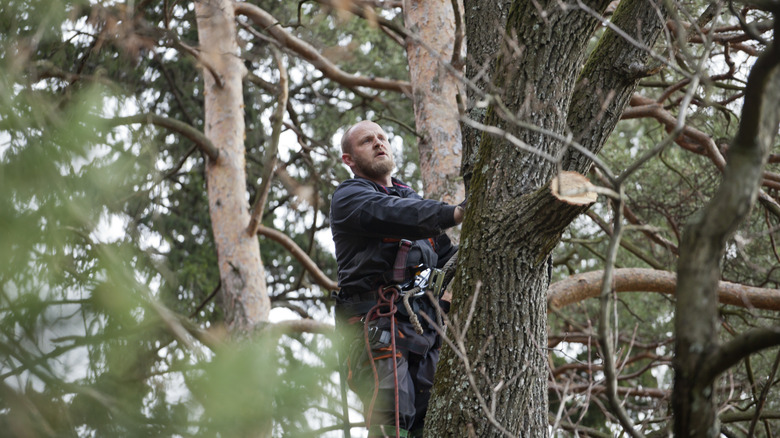Why You Should Think Twice Before Cutting Down A Rotten Tree Yourself
There's a lot you need to know to cut down trees in your yard. Cutting down a tree is a big job, one that carries certain risks, no matter the condition, size, or type of tree. But when you have a tree that's no longer adding value to your landscape or is a safety risk because it's rotten, cutting down the tree may be an important task, but it can be expensive. Still, in most situations, it's best to turn to a professional who has all of the necessary equipment to do this job, minimizing any risk to you. Cutting down a rotten tree yourself means you'll need to predict how the tree will fall and then take steps to minimize any damage to the surrounding area. The key here is that these trees may not act in the way you expect, increasing the risk of injury to you or damage to your property.
In fact, rotten trees can be hard to distinguish from healthy ones. You'll likely know it's a rotten tree if the bark is coming off or the tree is starting to lean to one side. If your tree no longer has leaves on it or there is a significant amount of pest activity, those are also signs that you may have a rotting tree. Before you decide to cut down this tree yourself, think about whether the risks outweigh the benefits.
Know the risks of cutting down a rotten tree
Emphatically, rotting trees should be handled by professionals. These trees tend to be more likely to cause complications as they come down. That's because if the interior is rotted out, the rest of the tree may virtually fall apart as you begin to cut it, coming down in various directions, out of your control. By contrast, when cutting down a healthier tree, you'll have better control over the cut you make, the direction of the fall, and even the rate at which it falls. All that goes out the window when it comes to rotten trees for several reasons. First, you don't likely know the extensiveness of the rot. It could go up through the trunk, and when you start cutting, that could mean a significant amount of tree falling at once. You also don't know how intact the root system is, which also means the tree is more precariously positioned and at a higher risk of toppling over unexpectedly, as well as sending heavy branches raining down on you.
Are you unsure that the tree is rotten? To determine if the tree is hollow inside, you can strike it with the back of an axe to get an idea (if the tree sounds hollow, it might be). You can also use a borer tool to penetrate the tree to determine its hollowness. The more fragile the tree is, the more likely it is to be too dangerous to take down on your own without the proper safety equipment.
What you can do about rotten trees
If you notice signs of a rotten tree, contact a tree professional for an inspection. Signs include large pieces of bark falling off, as well as rot or fungus that's visible on the exterior of the tree. In addition, the tree may be leaning to one side. If the tree is in immediate danger of tumbling over, clear the surrounding area. You may want to try to get emergency tree service to your property if you suspect the tree will fall onto your home or cause injury to a person.
It's not always possible to have someone come out to your home immediately. If you want to minimize at least some of the risk before a professional cuts it down, anchor the tree with 18-inch spikes going into the ground surrounding the tree, and with straps specifically made for staking trees in place around the trunk as well. This doesn't fix the problem, but it's a safe option until a tree removal team can arrive. As noted, though, it's usually best to leave cutting down rotten trees to the pros just for safety's sake. If you're not sure that the tree is hollow or that you can cut down the tree, reach out to a local professional for guidance on how to determine how safe the process may be.


